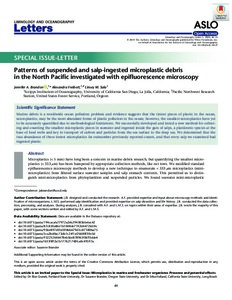Patterns of suspended and salp-ingested microplastic debris in the North Pacific investigated with epifluorescence microscopy.

View/
Average rating
votes
Date
2020Author
Brandon, Jennifer A.
Freibott, Alexandra
Sala, Linsey M.
Metadata
Show full item recordAbstract
Microplastics (< 5 mm) have long been a concern in marine debris research, but quantifying the smallest microplastics
(< 333 μm) has been hampered by appropriate collection methods, like net tows. We modified standard
epifluorescence microscopy methods to develop a new technique to enumerate < 333 μm microplastics (minimicroplastics)
from filtered surface seawater samples and salp stomach contents. This permitted us to distinguish
mini-microplastics from phytoplankton and suspended particles. We found seawater mini-microplastic concentrations that were 5–7 orders of magnitude higher than published concentrations of > 333 μm microplastics.
Mini-microplastics were the most abundant in nearshore waters and more evenly distributed from the
California Current through the North Pacific Subtropical Gyre. Every salp examined had ingested mini-microplastics,
regardless of species, life history stage, or oceanic region. Salps ingested significantly smaller plastic particles
than were ava.....
Journal
Limnology and Oceanography LettersVolume
5Page Range
pp.46–53Document Language
enSustainable Development Goals (SDG)
14.1Maturity Level
TRL 7 System prototyping demonstration in an operational environment (ground or space)Best Practice Type
Manual (incl. handbook, guide, cookbook etc)Spatial Coverage
California CurrentNorth Pacific Subtropical Gyre
DOI Original
10.1002/lol2.10127Citation
Brandon, J.A.; Freibott, A. and Sala, L.M. (2020) Patterns of suspended and salp‐ingested microplastic debris in the North Pacific investigated with epifluorescence microscopy. Limnology and Oceanography Letters, 5, pp. 46-53. DOI:10.1002/lol2.10127Collections
The following license files are associated with this item:
 Repository of community practices in Ocean Research, Applications and Data/Information Management
Repository of community practices in Ocean Research, Applications and Data/Information Management
